Knowledge Assessment: Provide Care for Babies and Toddlers (CHCECE005)
VerifiedAdded on 2022/12/27
|13
|2413
|30
Homework Assignment
AI Summary
This assignment comprehensively addresses the essential aspects of caring for babies and toddlers. It begins by examining safe sleep practices, including SUDI (Sudden Unexplained Death of Infants) safe practices, infection control, and sleep agreements. The assignment then delves into brain development, exploring true/false statements, strategies for supporting healthy brain development, and the importance of 'serve and return' interactions. Further, the assignment addresses nappy changing, toilet training, and hygiene, including responsibilities of approved providers, educators, and parents, as well as hygiene and safety practices, signs of toilet training readiness, and strategies to reduce cross-infection. Finally, it explores appropriate interactions, relationships, and individual differences, including accommodating individual sleep needs, applying UNCROC Article 30, and recognizing emotional states in babies and toddlers. The assignment provides a detailed overview of these topics to ensure the children’s physical and emotional wellbeing is maintained.

Provide care for babies and toodlers
Paraphrase This Document
Need a fresh take? Get an instant paraphrase of this document with our AI Paraphraser
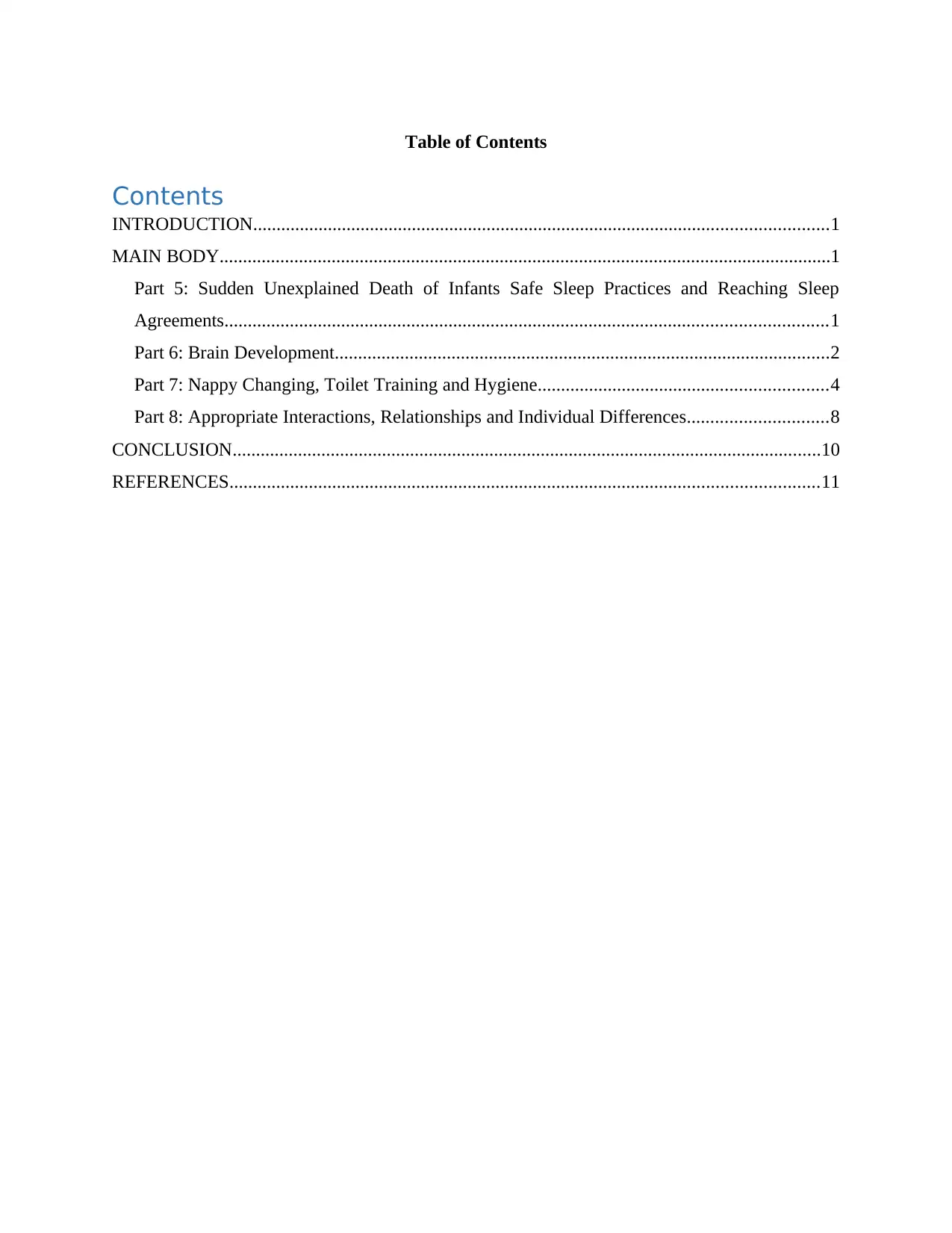
Table of Contents
Contents
INTRODUCTION...........................................................................................................................1
MAIN BODY...................................................................................................................................1
Part 5: Sudden Unexplained Death of Infants Safe Sleep Practices and Reaching Sleep
Agreements.................................................................................................................................1
Part 6: Brain Development..........................................................................................................2
Part 7: Nappy Changing, Toilet Training and Hygiene..............................................................4
Part 8: Appropriate Interactions, Relationships and Individual Differences..............................8
CONCLUSION..............................................................................................................................10
REFERENCES..............................................................................................................................11
Contents
INTRODUCTION...........................................................................................................................1
MAIN BODY...................................................................................................................................1
Part 5: Sudden Unexplained Death of Infants Safe Sleep Practices and Reaching Sleep
Agreements.................................................................................................................................1
Part 6: Brain Development..........................................................................................................2
Part 7: Nappy Changing, Toilet Training and Hygiene..............................................................4
Part 8: Appropriate Interactions, Relationships and Individual Differences..............................8
CONCLUSION..............................................................................................................................10
REFERENCES..............................................................................................................................11
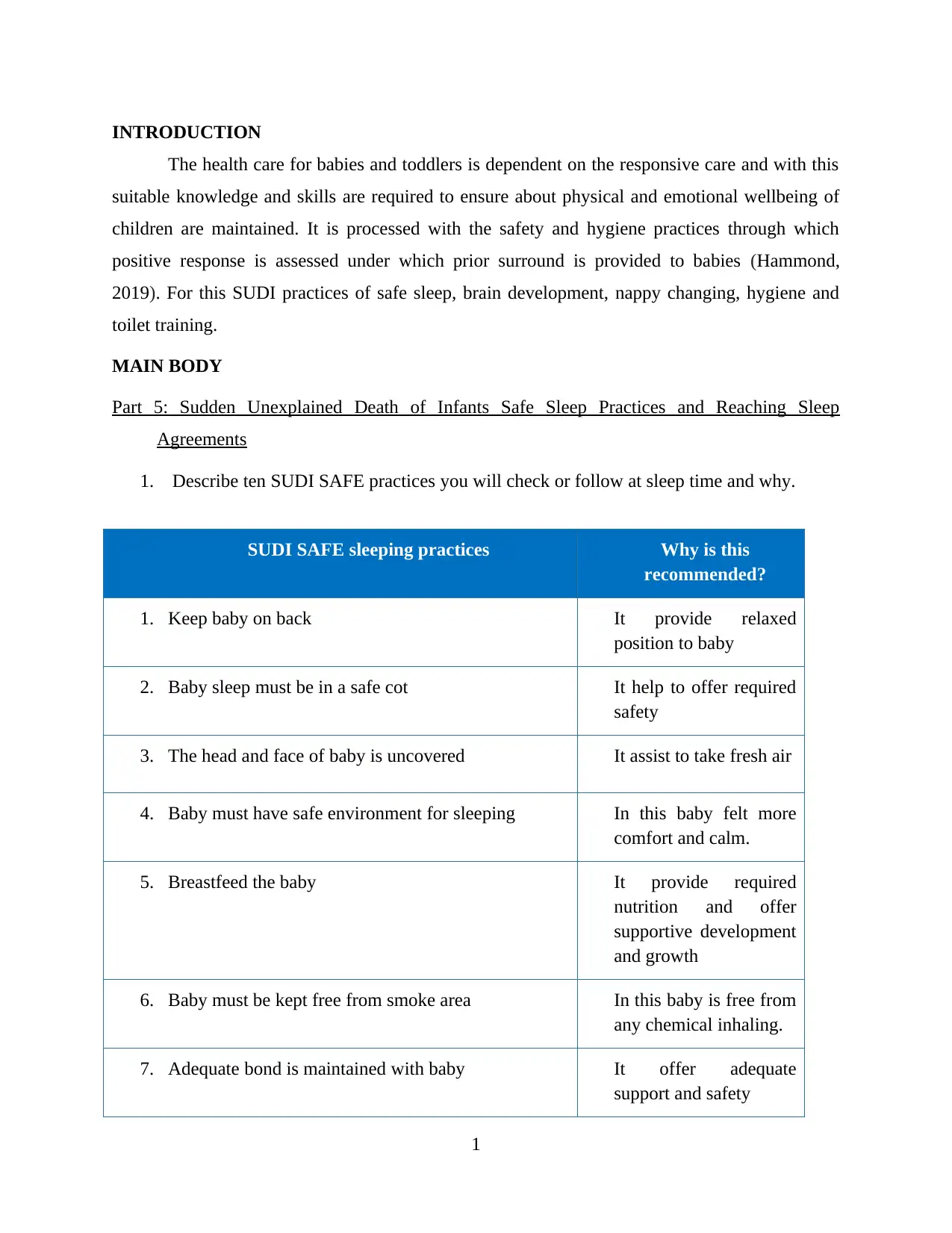
INTRODUCTION
The health care for babies and toddlers is dependent on the responsive care and with this
suitable knowledge and skills are required to ensure about physical and emotional wellbeing of
children are maintained. It is processed with the safety and hygiene practices through which
positive response is assessed under which prior surround is provided to babies (Hammond,
2019). For this SUDI practices of safe sleep, brain development, nappy changing, hygiene and
toilet training.
MAIN BODY
Part 5: Sudden Unexplained Death of Infants Safe Sleep Practices and Reaching Sleep
Agreements
1. Describe ten SUDI SAFE practices you will check or follow at sleep time and why.
SUDI SAFE sleeping practices Why is this
recommended?
1. Keep baby on back It provide relaxed
position to baby
2. Baby sleep must be in a safe cot It help to offer required
safety
3. The head and face of baby is uncovered It assist to take fresh air
4. Baby must have safe environment for sleeping In this baby felt more
comfort and calm.
5. Breastfeed the baby It provide required
nutrition and offer
supportive development
and growth
6. Baby must be kept free from smoke area In this baby is free from
any chemical inhaling.
7. Adequate bond is maintained with baby It offer adequate
support and safety
1
The health care for babies and toddlers is dependent on the responsive care and with this
suitable knowledge and skills are required to ensure about physical and emotional wellbeing of
children are maintained. It is processed with the safety and hygiene practices through which
positive response is assessed under which prior surround is provided to babies (Hammond,
2019). For this SUDI practices of safe sleep, brain development, nappy changing, hygiene and
toilet training.
MAIN BODY
Part 5: Sudden Unexplained Death of Infants Safe Sleep Practices and Reaching Sleep
Agreements
1. Describe ten SUDI SAFE practices you will check or follow at sleep time and why.
SUDI SAFE sleeping practices Why is this
recommended?
1. Keep baby on back It provide relaxed
position to baby
2. Baby sleep must be in a safe cot It help to offer required
safety
3. The head and face of baby is uncovered It assist to take fresh air
4. Baby must have safe environment for sleeping In this baby felt more
comfort and calm.
5. Breastfeed the baby It provide required
nutrition and offer
supportive development
and growth
6. Baby must be kept free from smoke area In this baby is free from
any chemical inhaling.
7. Adequate bond is maintained with baby It offer adequate
support and safety
1
⊘ This is a preview!⊘
Do you want full access?
Subscribe today to unlock all pages.

Trusted by 1+ million students worldwide
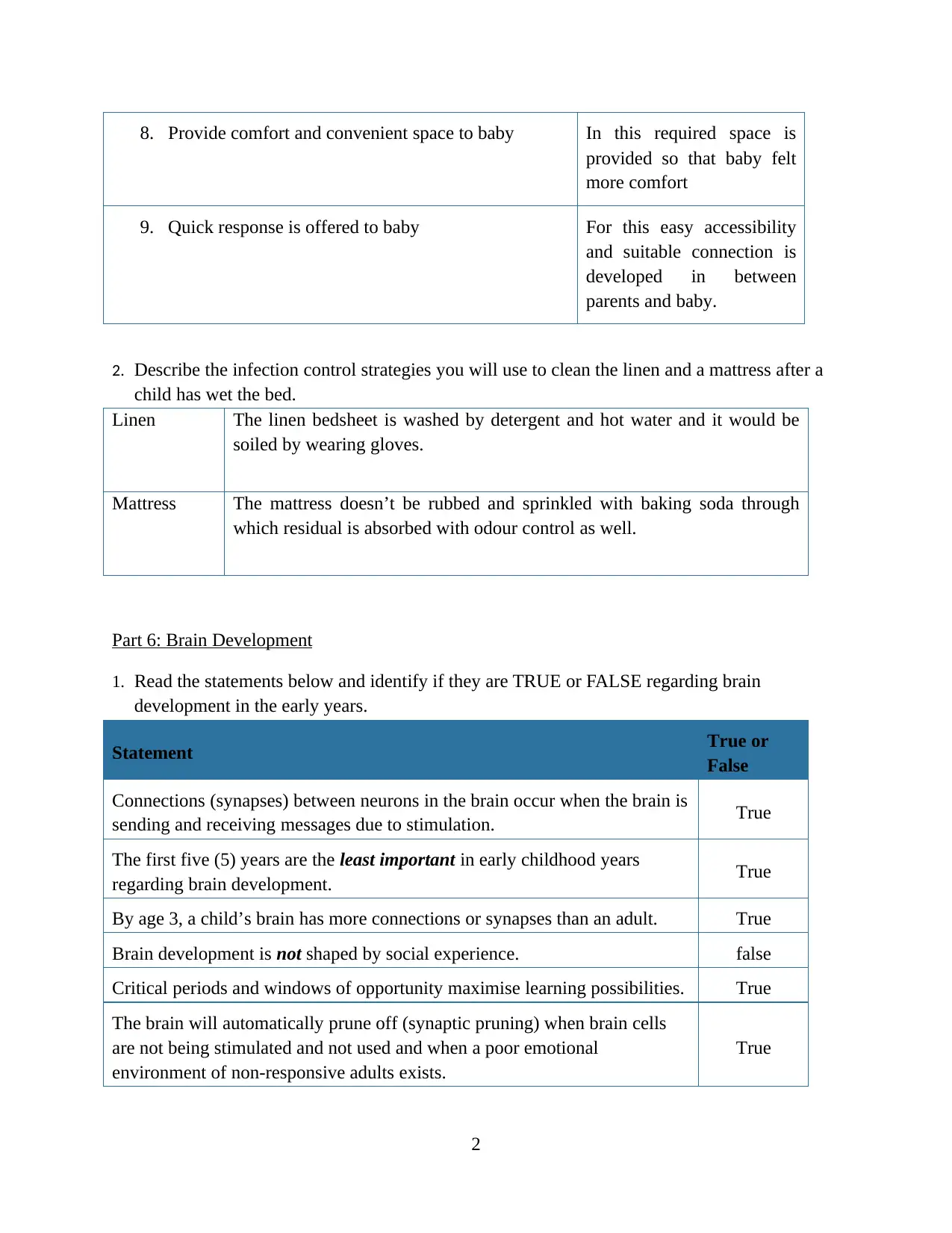
8. Provide comfort and convenient space to baby In this required space is
provided so that baby felt
more comfort
9. Quick response is offered to baby For this easy accessibility
and suitable connection is
developed in between
parents and baby.
2. Describe the infection control strategies you will use to clean the linen and a mattress after a
child has wet the bed.
Linen The linen bedsheet is washed by detergent and hot water and it would be
soiled by wearing gloves.
Mattress The mattress doesn’t be rubbed and sprinkled with baking soda through
which residual is absorbed with odour control as well.
Part 6: Brain Development
1. Read the statements below and identify if they are TRUE or FALSE regarding brain
development in the early years.
Statement True or
False
Connections (synapses) between neurons in the brain occur when the brain is
sending and receiving messages due to stimulation. True
The first five (5) years are the least important in early childhood years
regarding brain development. True
By age 3, a child’s brain has more connections or synapses than an adult. True
Brain development is not shaped by social experience. false
Critical periods and windows of opportunity maximise learning possibilities. True
The brain will automatically prune off (synaptic pruning) when brain cells
are not being stimulated and not used and when a poor emotional
environment of non-responsive adults exists.
True
2
provided so that baby felt
more comfort
9. Quick response is offered to baby For this easy accessibility
and suitable connection is
developed in between
parents and baby.
2. Describe the infection control strategies you will use to clean the linen and a mattress after a
child has wet the bed.
Linen The linen bedsheet is washed by detergent and hot water and it would be
soiled by wearing gloves.
Mattress The mattress doesn’t be rubbed and sprinkled with baking soda through
which residual is absorbed with odour control as well.
Part 6: Brain Development
1. Read the statements below and identify if they are TRUE or FALSE regarding brain
development in the early years.
Statement True or
False
Connections (synapses) between neurons in the brain occur when the brain is
sending and receiving messages due to stimulation. True
The first five (5) years are the least important in early childhood years
regarding brain development. True
By age 3, a child’s brain has more connections or synapses than an adult. True
Brain development is not shaped by social experience. false
Critical periods and windows of opportunity maximise learning possibilities. True
The brain will automatically prune off (synaptic pruning) when brain cells
are not being stimulated and not used and when a poor emotional
environment of non-responsive adults exists.
True
2
Paraphrase This Document
Need a fresh take? Get an instant paraphrase of this document with our AI Paraphraser
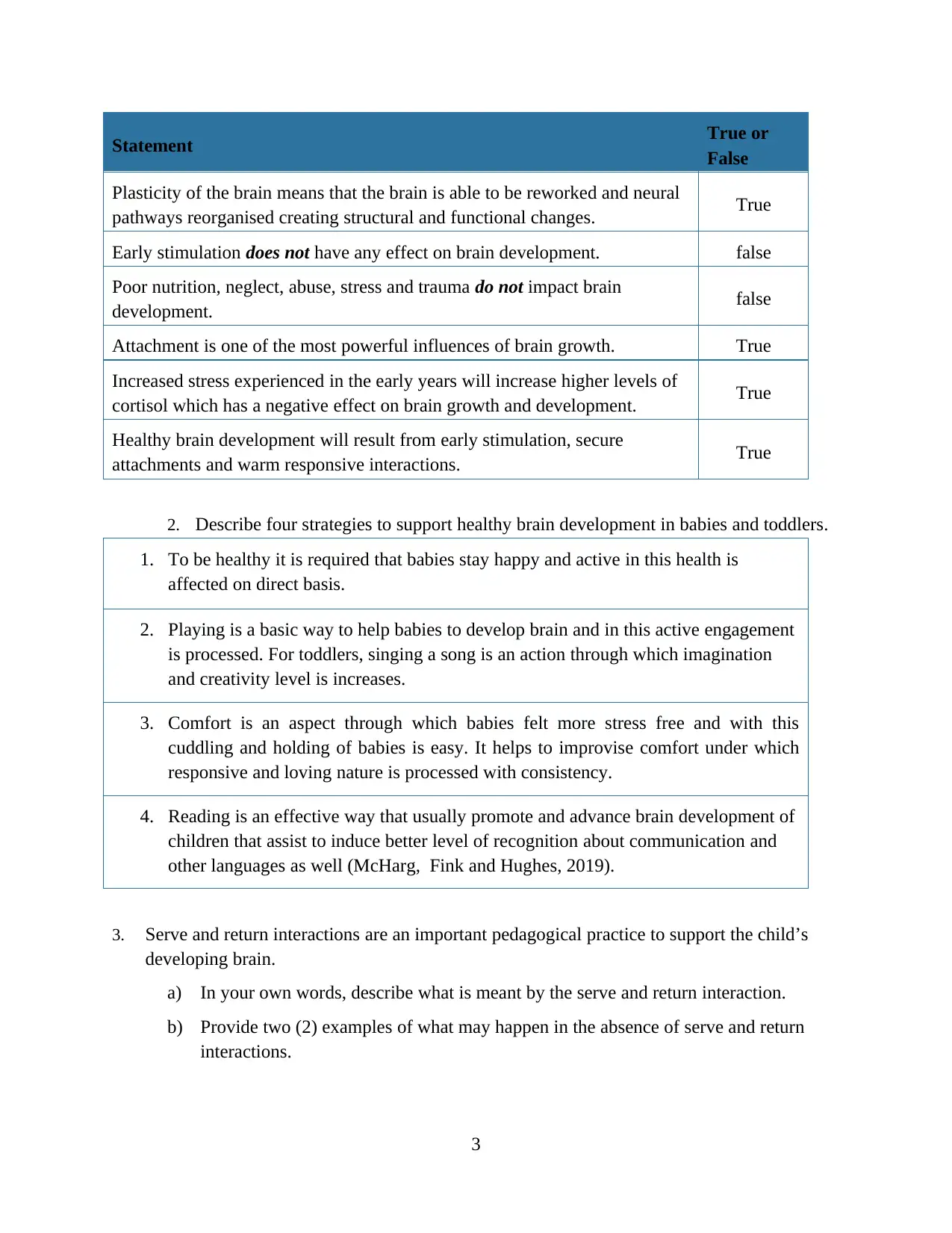
Statement True or
False
Plasticity of the brain means that the brain is able to be reworked and neural
pathways reorganised creating structural and functional changes. True
Early stimulation does not have any effect on brain development. false
Poor nutrition, neglect, abuse, stress and trauma do not impact brain
development. false
Attachment is one of the most powerful influences of brain growth. True
Increased stress experienced in the early years will increase higher levels of
cortisol which has a negative effect on brain growth and development. True
Healthy brain development will result from early stimulation, secure
attachments and warm responsive interactions. True
2. Describe four strategies to support healthy brain development in babies and toddlers.
1. To be healthy it is required that babies stay happy and active in this health is
affected on direct basis.
2. Playing is a basic way to help babies to develop brain and in this active engagement
is processed. For toddlers, singing a song is an action through which imagination
and creativity level is increases.
3. Comfort is an aspect through which babies felt more stress free and with this
cuddling and holding of babies is easy. It helps to improvise comfort under which
responsive and loving nature is processed with consistency.
4. Reading is an effective way that usually promote and advance brain development of
children that assist to induce better level of recognition about communication and
other languages as well (McHarg, Fink and Hughes, 2019).
3. Serve and return interactions are an important pedagogical practice to support the child’s
developing brain.
a) In your own words, describe what is meant by the serve and return interaction.
b) Provide two (2) examples of what may happen in the absence of serve and return
interactions.
3
False
Plasticity of the brain means that the brain is able to be reworked and neural
pathways reorganised creating structural and functional changes. True
Early stimulation does not have any effect on brain development. false
Poor nutrition, neglect, abuse, stress and trauma do not impact brain
development. false
Attachment is one of the most powerful influences of brain growth. True
Increased stress experienced in the early years will increase higher levels of
cortisol which has a negative effect on brain growth and development. True
Healthy brain development will result from early stimulation, secure
attachments and warm responsive interactions. True
2. Describe four strategies to support healthy brain development in babies and toddlers.
1. To be healthy it is required that babies stay happy and active in this health is
affected on direct basis.
2. Playing is a basic way to help babies to develop brain and in this active engagement
is processed. For toddlers, singing a song is an action through which imagination
and creativity level is increases.
3. Comfort is an aspect through which babies felt more stress free and with this
cuddling and holding of babies is easy. It helps to improvise comfort under which
responsive and loving nature is processed with consistency.
4. Reading is an effective way that usually promote and advance brain development of
children that assist to induce better level of recognition about communication and
other languages as well (McHarg, Fink and Hughes, 2019).
3. Serve and return interactions are an important pedagogical practice to support the child’s
developing brain.
a) In your own words, describe what is meant by the serve and return interaction.
b) Provide two (2) examples of what may happen in the absence of serve and return
interactions.
3
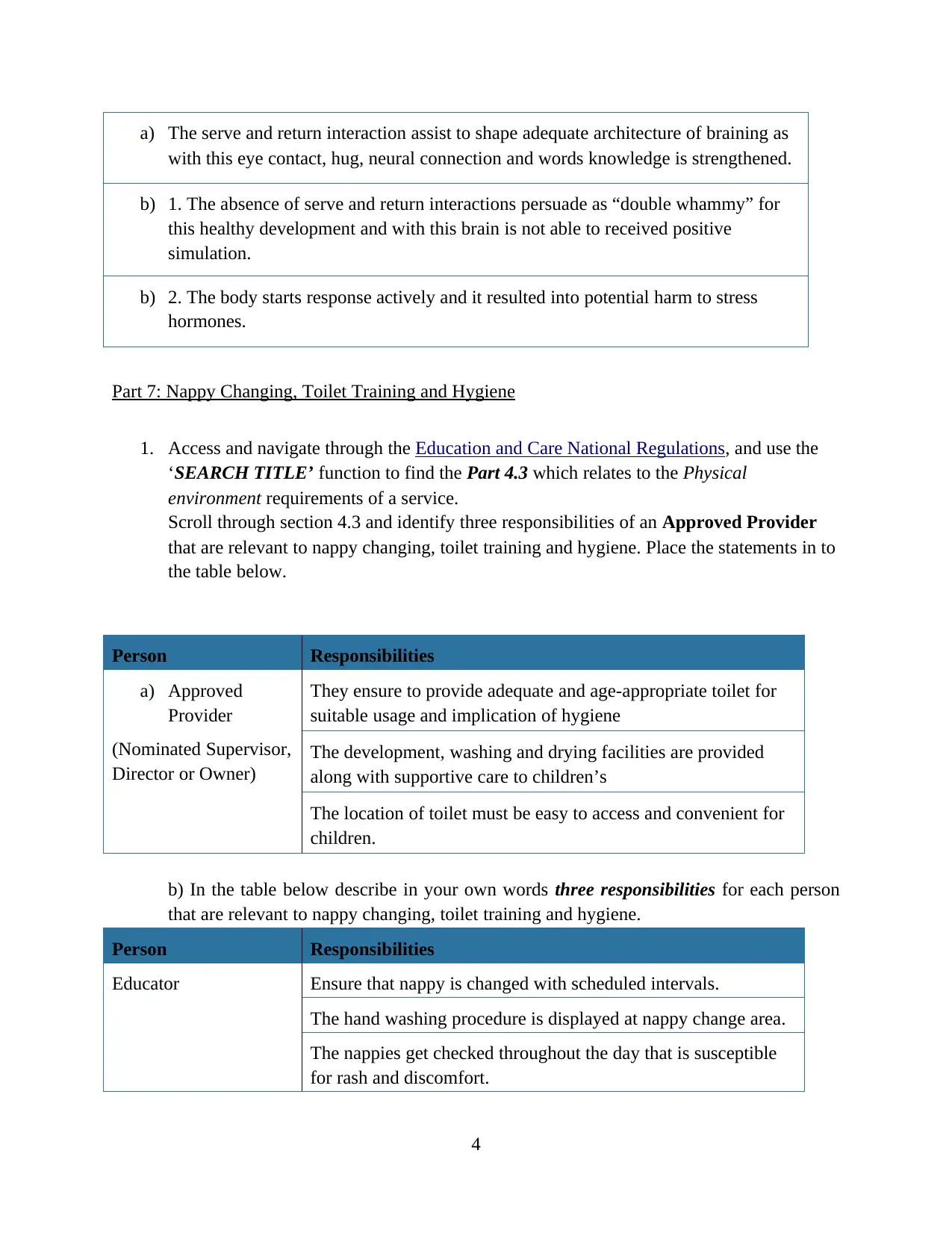
a) The serve and return interaction assist to shape adequate architecture of braining as
with this eye contact, hug, neural connection and words knowledge is strengthened.
b) 1. The absence of serve and return interactions persuade as “double whammy” for
this healthy development and with this brain is not able to received positive
simulation.
b) 2. The body starts response actively and it resulted into potential harm to stress
hormones.
Part 7: Nappy Changing, Toilet Training and Hygiene
1. Access and navigate through the Education and Care National Regulations, and use the
‘SEARCH TITLE’ function to find the Part 4.3 which relates to the Physical
environment requirements of a service.
Scroll through section 4.3 and identify three responsibilities of an Approved Provider
that are relevant to nappy changing, toilet training and hygiene. Place the statements in to
the table below.
Person Responsibilities
a) Approved
Provider
(Nominated Supervisor,
Director or Owner)
They ensure to provide adequate and age-appropriate toilet for
suitable usage and implication of hygiene
The development, washing and drying facilities are provided
along with supportive care to children’s
The location of toilet must be easy to access and convenient for
children.
b) In the table below describe in your own words three responsibilities for each person
that are relevant to nappy changing, toilet training and hygiene.
Person Responsibilities
Educator Ensure that nappy is changed with scheduled intervals.
The hand washing procedure is displayed at nappy change area.
The nappies get checked throughout the day that is susceptible
for rash and discomfort.
4
with this eye contact, hug, neural connection and words knowledge is strengthened.
b) 1. The absence of serve and return interactions persuade as “double whammy” for
this healthy development and with this brain is not able to received positive
simulation.
b) 2. The body starts response actively and it resulted into potential harm to stress
hormones.
Part 7: Nappy Changing, Toilet Training and Hygiene
1. Access and navigate through the Education and Care National Regulations, and use the
‘SEARCH TITLE’ function to find the Part 4.3 which relates to the Physical
environment requirements of a service.
Scroll through section 4.3 and identify three responsibilities of an Approved Provider
that are relevant to nappy changing, toilet training and hygiene. Place the statements in to
the table below.
Person Responsibilities
a) Approved
Provider
(Nominated Supervisor,
Director or Owner)
They ensure to provide adequate and age-appropriate toilet for
suitable usage and implication of hygiene
The development, washing and drying facilities are provided
along with supportive care to children’s
The location of toilet must be easy to access and convenient for
children.
b) In the table below describe in your own words three responsibilities for each person
that are relevant to nappy changing, toilet training and hygiene.
Person Responsibilities
Educator Ensure that nappy is changed with scheduled intervals.
The hand washing procedure is displayed at nappy change area.
The nappies get checked throughout the day that is susceptible
for rash and discomfort.
4
⊘ This is a preview!⊘
Do you want full access?
Subscribe today to unlock all pages.

Trusted by 1+ million students worldwide
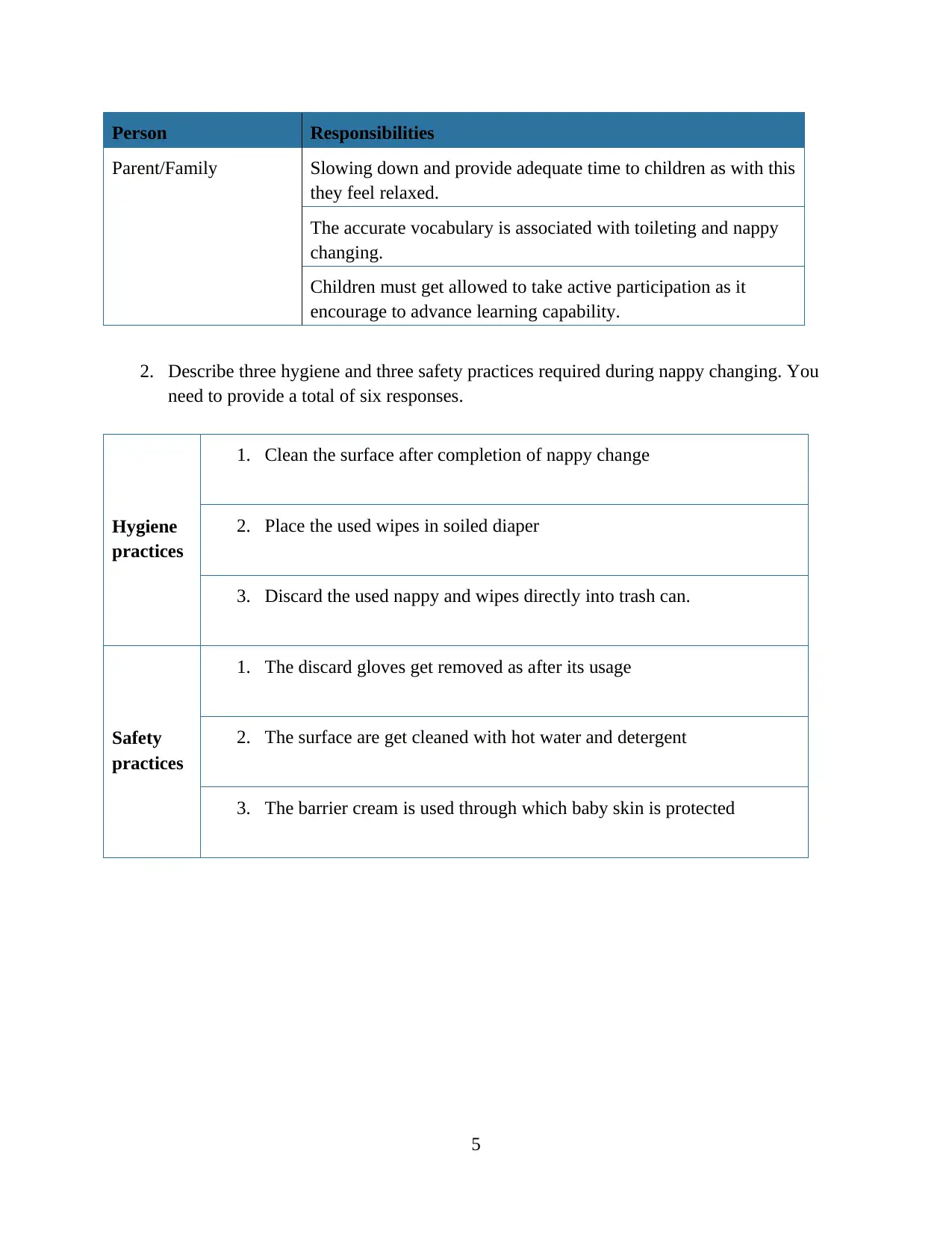
Person Responsibilities
Parent/Family Slowing down and provide adequate time to children as with this
they feel relaxed.
The accurate vocabulary is associated with toileting and nappy
changing.
Children must get allowed to take active participation as it
encourage to advance learning capability.
2. Describe three hygiene and three safety practices required during nappy changing. You
need to provide a total of six responses.
Hygiene
practices
1. Clean the surface after completion of nappy change
2. Place the used wipes in soiled diaper
3. Discard the used nappy and wipes directly into trash can.
Safety
practices
1. The discard gloves get removed as after its usage
2. The surface are get cleaned with hot water and detergent
3. The barrier cream is used through which baby skin is protected
5
Parent/Family Slowing down and provide adequate time to children as with this
they feel relaxed.
The accurate vocabulary is associated with toileting and nappy
changing.
Children must get allowed to take active participation as it
encourage to advance learning capability.
2. Describe three hygiene and three safety practices required during nappy changing. You
need to provide a total of six responses.
Hygiene
practices
1. Clean the surface after completion of nappy change
2. Place the used wipes in soiled diaper
3. Discard the used nappy and wipes directly into trash can.
Safety
practices
1. The discard gloves get removed as after its usage
2. The surface are get cleaned with hot water and detergent
3. The barrier cream is used through which baby skin is protected
5
Paraphrase This Document
Need a fresh take? Get an instant paraphrase of this document with our AI Paraphraser
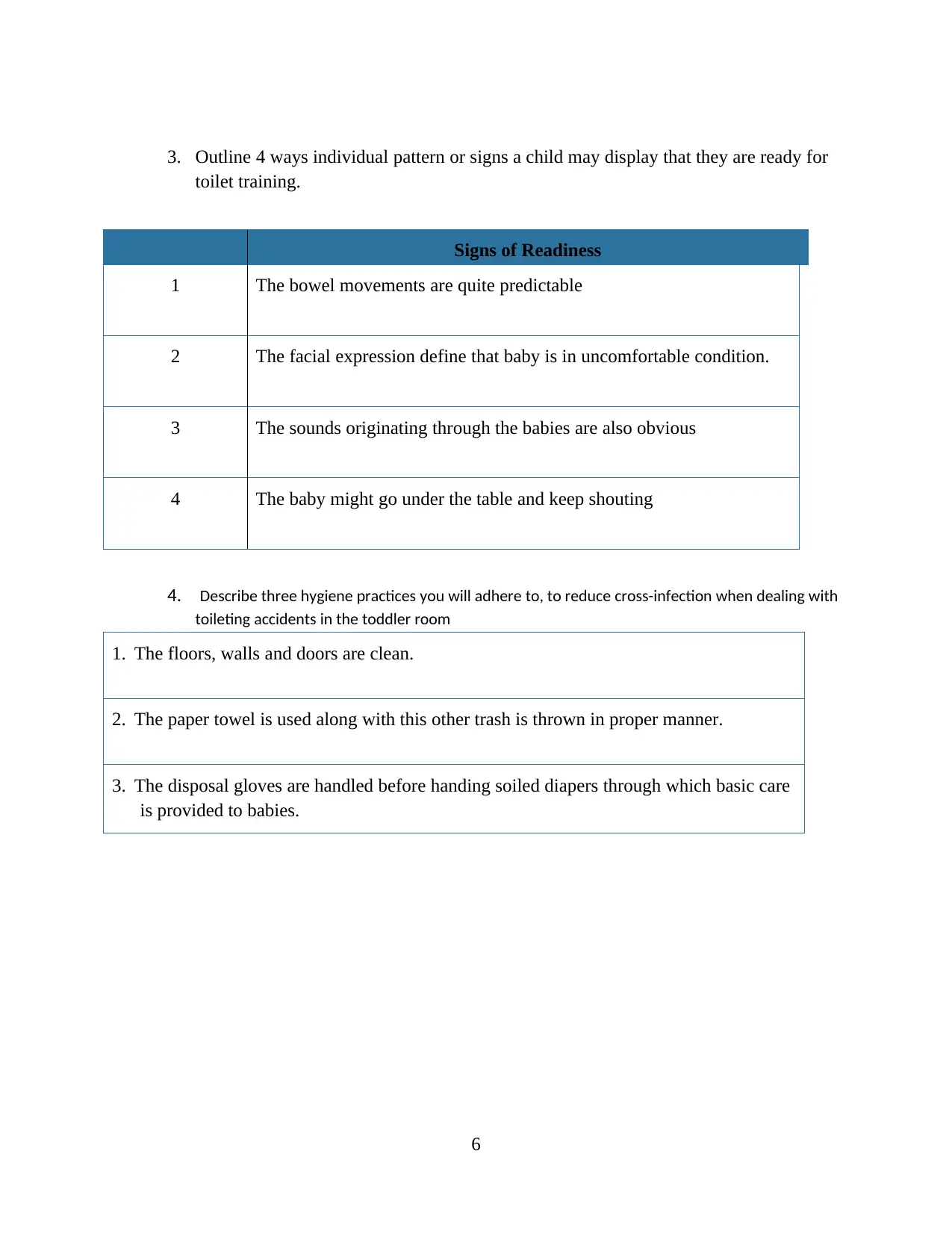
3. Outline 4 ways individual pattern or signs a child may display that they are ready for
toilet training.
Signs of Readiness
1 The bowel movements are quite predictable
2 The facial expression define that baby is in uncomfortable condition.
3 The sounds originating through the babies are also obvious
4 The baby might go under the table and keep shouting
4. Describe three hygiene practices you will adhere to, to reduce cross-infection when dealing with
toileting accidents in the toddler room
1. The floors, walls and doors are clean.
2. The paper towel is used along with this other trash is thrown in proper manner.
3. The disposal gloves are handled before handing soiled diapers through which basic care
is provided to babies.
6
toilet training.
Signs of Readiness
1 The bowel movements are quite predictable
2 The facial expression define that baby is in uncomfortable condition.
3 The sounds originating through the babies are also obvious
4 The baby might go under the table and keep shouting
4. Describe three hygiene practices you will adhere to, to reduce cross-infection when dealing with
toileting accidents in the toddler room
1. The floors, walls and doors are clean.
2. The paper towel is used along with this other trash is thrown in proper manner.
3. The disposal gloves are handled before handing soiled diapers through which basic care
is provided to babies.
6
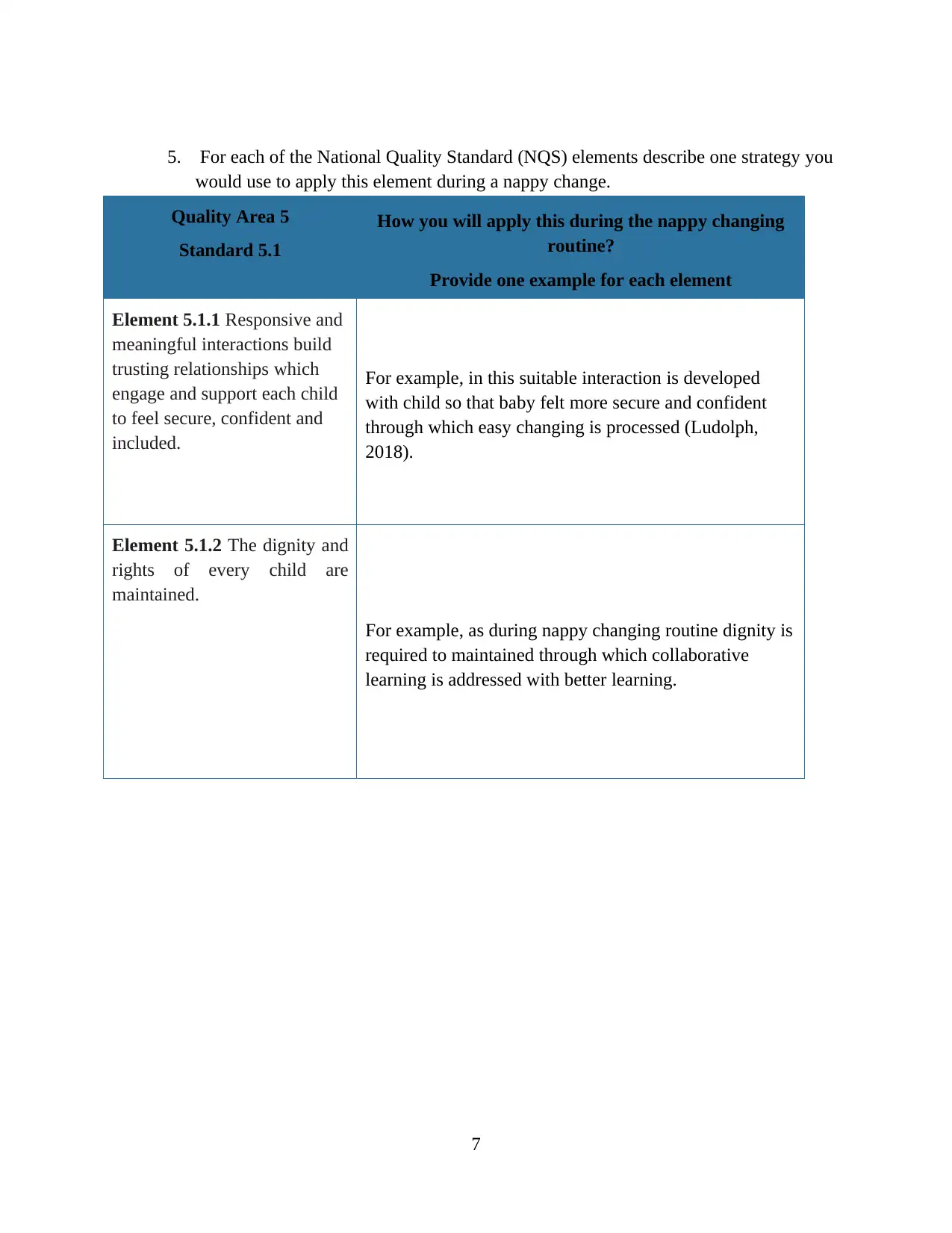
5. For each of the National Quality Standard (NQS) elements describe one strategy you
would use to apply this element during a nappy change.
Quality Area 5
Standard 5.1
How you will apply this during the nappy changing
routine?
Provide one example for each element
Element 5.1.1 Responsive and
meaningful interactions build
trusting relationships which
engage and support each child
to feel secure, confident and
included.
For example, in this suitable interaction is developed
with child so that baby felt more secure and confident
through which easy changing is processed (Ludolph,
2018).
Element 5.1.2 The dignity and
rights of every child are
maintained.
For example, as during nappy changing routine dignity is
required to maintained through which collaborative
learning is addressed with better learning.
7
would use to apply this element during a nappy change.
Quality Area 5
Standard 5.1
How you will apply this during the nappy changing
routine?
Provide one example for each element
Element 5.1.1 Responsive and
meaningful interactions build
trusting relationships which
engage and support each child
to feel secure, confident and
included.
For example, in this suitable interaction is developed
with child so that baby felt more secure and confident
through which easy changing is processed (Ludolph,
2018).
Element 5.1.2 The dignity and
rights of every child are
maintained.
For example, as during nappy changing routine dignity is
required to maintained through which collaborative
learning is addressed with better learning.
7
⊘ This is a preview!⊘
Do you want full access?
Subscribe today to unlock all pages.

Trusted by 1+ million students worldwide
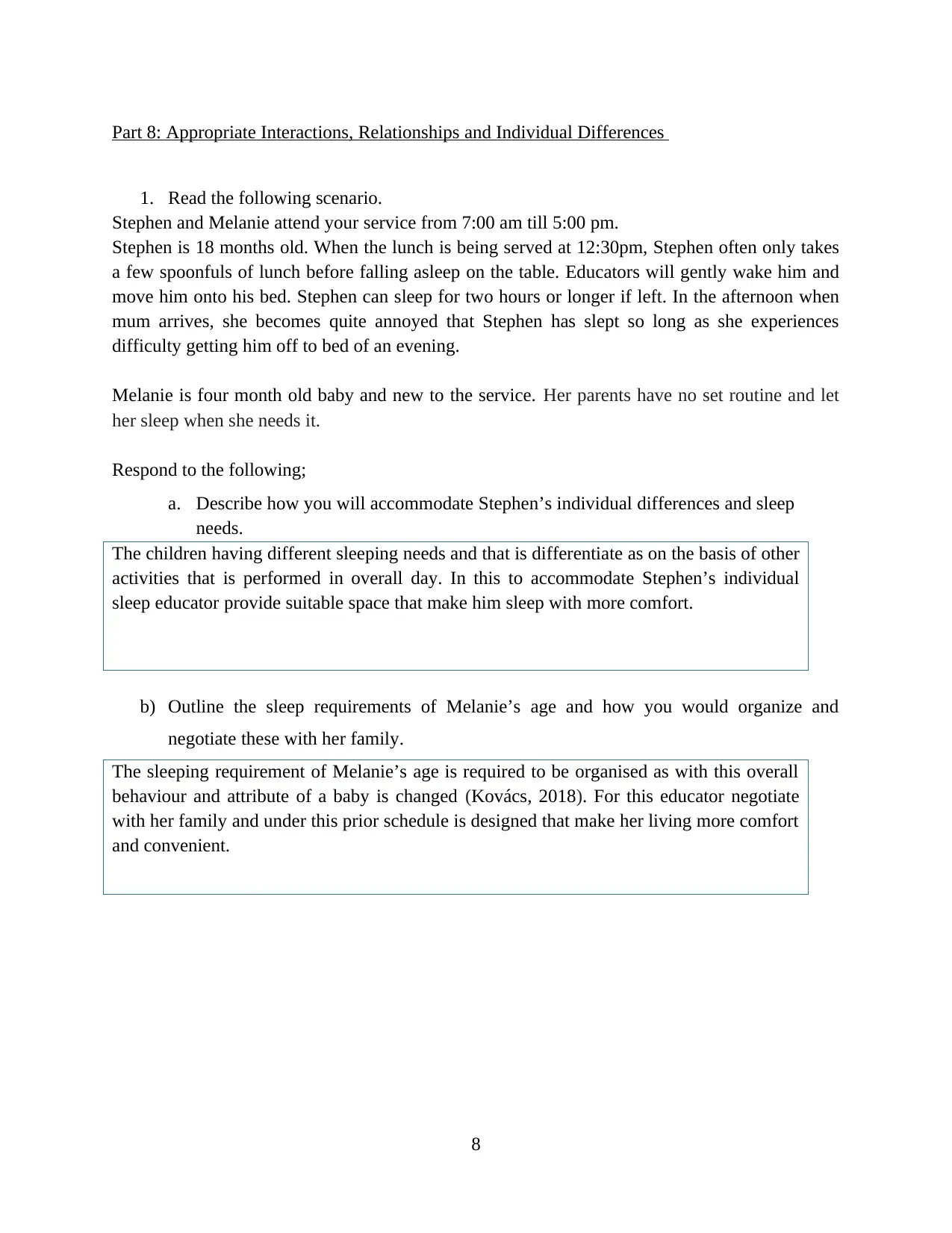
Part 8: Appropriate Interactions, Relationships and Individual Differences
1. Read the following scenario.
Stephen and Melanie attend your service from 7:00 am till 5:00 pm.
Stephen is 18 months old. When the lunch is being served at 12:30pm, Stephen often only takes
a few spoonfuls of lunch before falling asleep on the table. Educators will gently wake him and
move him onto his bed. Stephen can sleep for two hours or longer if left. In the afternoon when
mum arrives, she becomes quite annoyed that Stephen has slept so long as she experiences
difficulty getting him off to bed of an evening.
Melanie is four month old baby and new to the service. Her parents have no set routine and let
her sleep when she needs it.
Respond to the following;
a. Describe how you will accommodate Stephen’s individual differences and sleep
needs.
The children having different sleeping needs and that is differentiate as on the basis of other
activities that is performed in overall day. In this to accommodate Stephen’s individual
sleep educator provide suitable space that make him sleep with more comfort.
b) Outline the sleep requirements of Melanie’s age and how you would organize and
negotiate these with her family.
The sleeping requirement of Melanie’s age is required to be organised as with this overall
behaviour and attribute of a baby is changed (Kovács, 2018). For this educator negotiate
with her family and under this prior schedule is designed that make her living more comfort
and convenient.
8
1. Read the following scenario.
Stephen and Melanie attend your service from 7:00 am till 5:00 pm.
Stephen is 18 months old. When the lunch is being served at 12:30pm, Stephen often only takes
a few spoonfuls of lunch before falling asleep on the table. Educators will gently wake him and
move him onto his bed. Stephen can sleep for two hours or longer if left. In the afternoon when
mum arrives, she becomes quite annoyed that Stephen has slept so long as she experiences
difficulty getting him off to bed of an evening.
Melanie is four month old baby and new to the service. Her parents have no set routine and let
her sleep when she needs it.
Respond to the following;
a. Describe how you will accommodate Stephen’s individual differences and sleep
needs.
The children having different sleeping needs and that is differentiate as on the basis of other
activities that is performed in overall day. In this to accommodate Stephen’s individual
sleep educator provide suitable space that make him sleep with more comfort.
b) Outline the sleep requirements of Melanie’s age and how you would organize and
negotiate these with her family.
The sleeping requirement of Melanie’s age is required to be organised as with this overall
behaviour and attribute of a baby is changed (Kovács, 2018). For this educator negotiate
with her family and under this prior schedule is designed that make her living more comfort
and convenient.
8
Paraphrase This Document
Need a fresh take? Get an instant paraphrase of this document with our AI Paraphraser
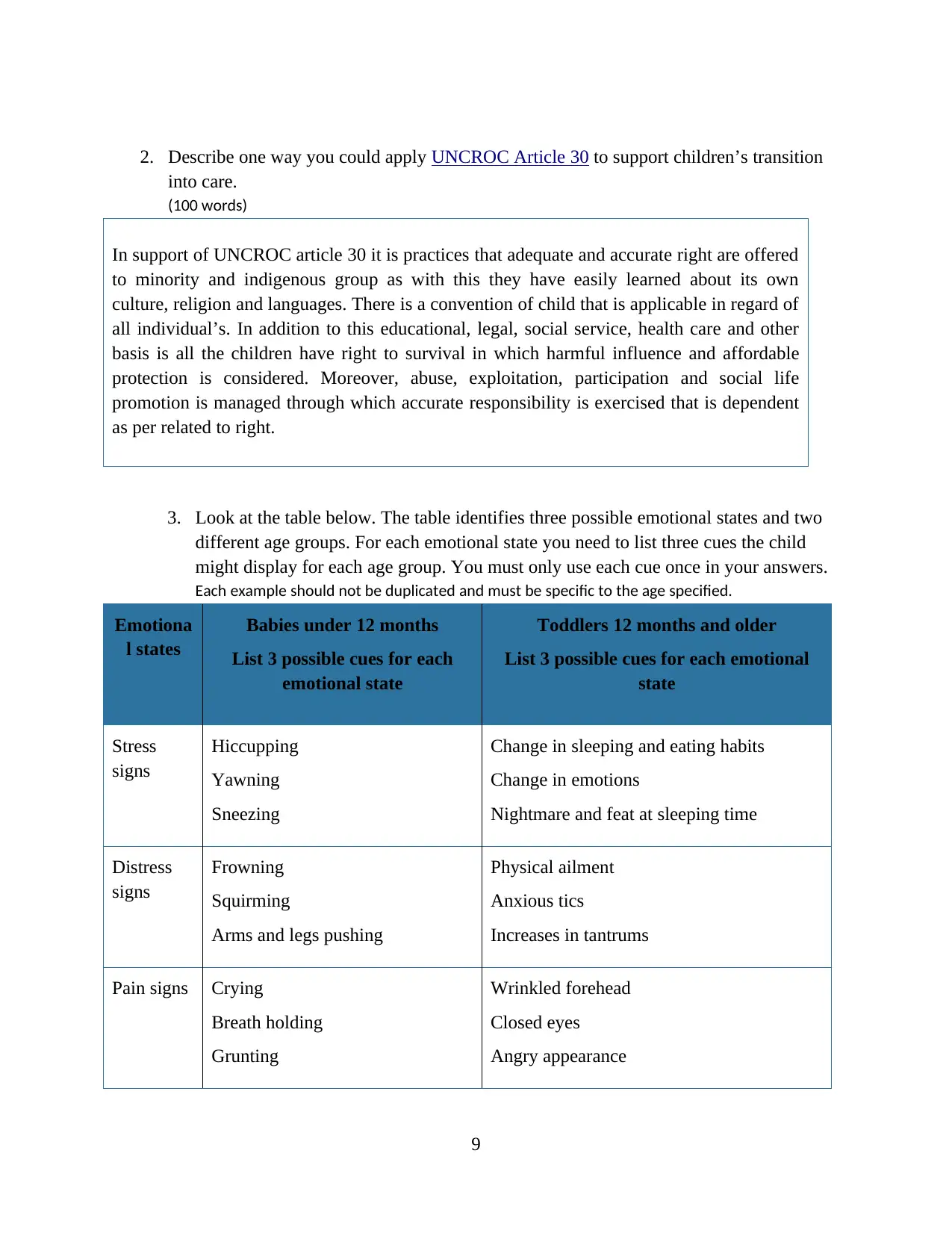
2. Describe one way you could apply UNCROC Article 30 to support children’s transition
into care.
(100 words)
In support of UNCROC article 30 it is practices that adequate and accurate right are offered
to minority and indigenous group as with this they have easily learned about its own
culture, religion and languages. There is a convention of child that is applicable in regard of
all individual’s. In addition to this educational, legal, social service, health care and other
basis is all the children have right to survival in which harmful influence and affordable
protection is considered. Moreover, abuse, exploitation, participation and social life
promotion is managed through which accurate responsibility is exercised that is dependent
as per related to right.
3. Look at the table below. The table identifies three possible emotional states and two
different age groups. For each emotional state you need to list three cues the child
might display for each age group. You must only use each cue once in your answers.
Each example should not be duplicated and must be specific to the age specified.
Emotiona
l states
Babies under 12 months
List 3 possible cues for each
emotional state
Toddlers 12 months and older
List 3 possible cues for each emotional
state
Stress
signs
Hiccupping
Yawning
Sneezing
Change in sleeping and eating habits
Change in emotions
Nightmare and feat at sleeping time
Distress
signs
Frowning
Squirming
Arms and legs pushing
Physical ailment
Anxious tics
Increases in tantrums
Pain signs Crying
Breath holding
Grunting
Wrinkled forehead
Closed eyes
Angry appearance
9
into care.
(100 words)
In support of UNCROC article 30 it is practices that adequate and accurate right are offered
to minority and indigenous group as with this they have easily learned about its own
culture, religion and languages. There is a convention of child that is applicable in regard of
all individual’s. In addition to this educational, legal, social service, health care and other
basis is all the children have right to survival in which harmful influence and affordable
protection is considered. Moreover, abuse, exploitation, participation and social life
promotion is managed through which accurate responsibility is exercised that is dependent
as per related to right.
3. Look at the table below. The table identifies three possible emotional states and two
different age groups. For each emotional state you need to list three cues the child
might display for each age group. You must only use each cue once in your answers.
Each example should not be duplicated and must be specific to the age specified.
Emotiona
l states
Babies under 12 months
List 3 possible cues for each
emotional state
Toddlers 12 months and older
List 3 possible cues for each emotional
state
Stress
signs
Hiccupping
Yawning
Sneezing
Change in sleeping and eating habits
Change in emotions
Nightmare and feat at sleeping time
Distress
signs
Frowning
Squirming
Arms and legs pushing
Physical ailment
Anxious tics
Increases in tantrums
Pain signs Crying
Breath holding
Grunting
Wrinkled forehead
Closed eyes
Angry appearance
9
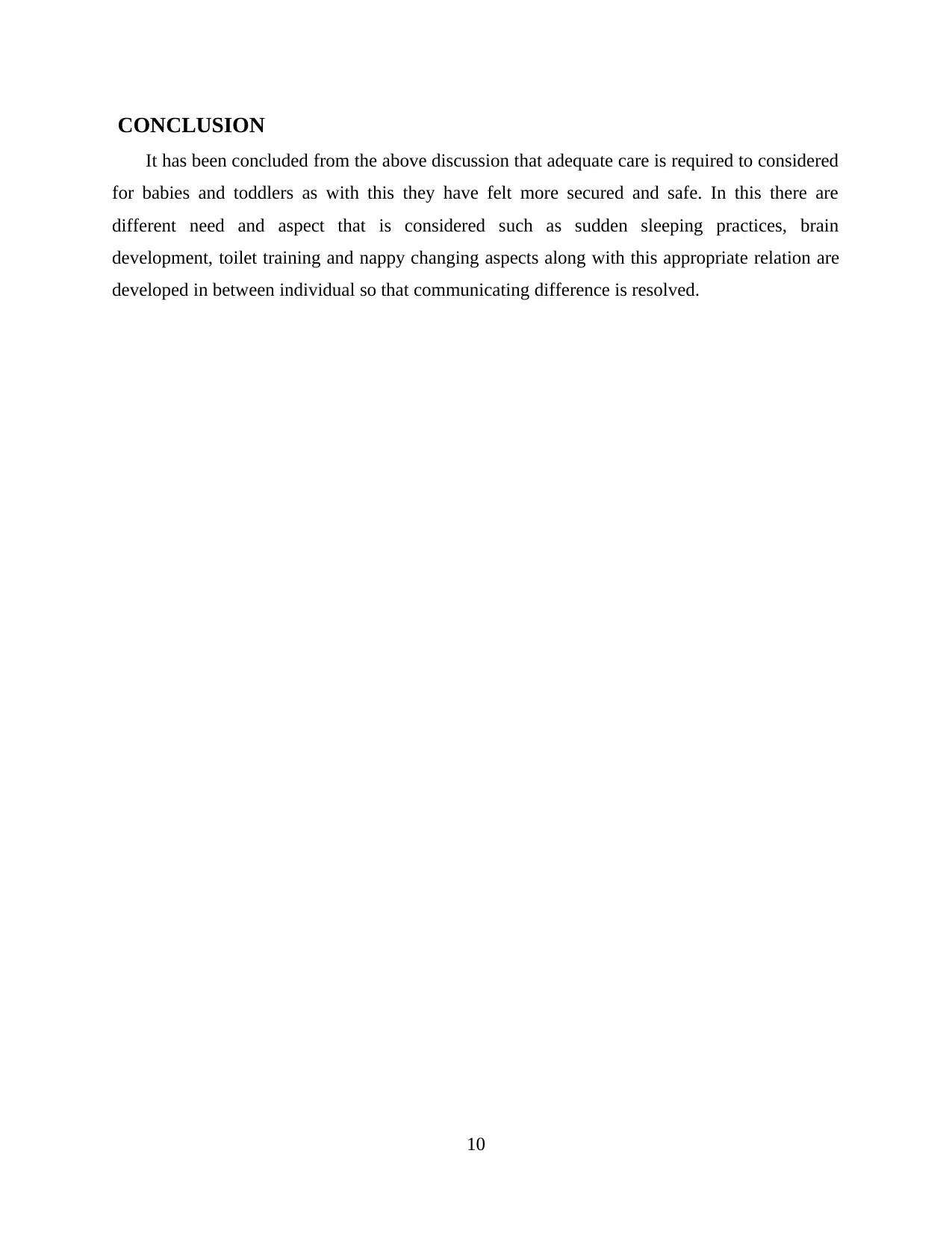
CONCLUSION
It has been concluded from the above discussion that adequate care is required to considered
for babies and toddlers as with this they have felt more secured and safe. In this there are
different need and aspect that is considered such as sudden sleeping practices, brain
development, toilet training and nappy changing aspects along with this appropriate relation are
developed in between individual so that communicating difference is resolved.
10
It has been concluded from the above discussion that adequate care is required to considered
for babies and toddlers as with this they have felt more secured and safe. In this there are
different need and aspect that is considered such as sudden sleeping practices, brain
development, toilet training and nappy changing aspects along with this appropriate relation are
developed in between individual so that communicating difference is resolved.
10
⊘ This is a preview!⊘
Do you want full access?
Subscribe today to unlock all pages.

Trusted by 1+ million students worldwide
1 out of 13
Your All-in-One AI-Powered Toolkit for Academic Success.
+13062052269
info@desklib.com
Available 24*7 on WhatsApp / Email
![[object Object]](/_next/static/media/star-bottom.7253800d.svg)
Unlock your academic potential
Copyright © 2020–2025 A2Z Services. All Rights Reserved. Developed and managed by ZUCOL.
